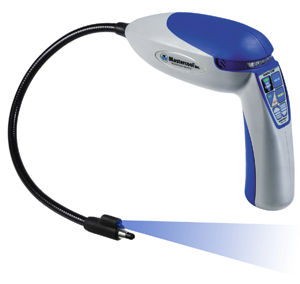Check For A/C Leaks

By Dennis Bandy Copyright © DenLorsTools.com
Low refrigerant (Freon, 134A) is the most common cause of an automotive A/C system blowing warm air. The refrigerant is used to transfer heat from the passenger compartment to the outside. Cars today hold considerably less refrigerant than cars of the past, so even small leaks can affect A/C performance in a short period of time. If low refrigerant is suspected, a 134a A/C gauge set can be used to verify this. The pressure with the A/C turned off should be approximately 80 PSI on the AC gauge set, depending on the ambient (outside) temperature.
If the system has less than 50 PSI reading on the AC gauge set, the system should be partially charged so a leak will be more likely to be picked up with a leak detector. A visual inspection should be performed to check for dye and/or oil (some manufacturers put UVdye in A/C systems from the factory). Check all AC components including the AC compressor front seal & evaporator drain tube. If the refrigerant leak is not evident, verify that dye is in the system or add dye (one method is with a dye injector).
You may then use an ultraviolet light (UV Light) also called a black light, to inspect all AC components. UV light kits are available or you can get the light separately. Unless the evaporator has a fast leak, it can be the most challenging component to check. The evaporator can be checked with an electronic AC leak detector at the evaporator drain tube (careful not to stick the probe in water). Another clever idea is to use a fiberoptic borescope to snake through the evaporator drain tube (most are water resistant). With the fiberoptic borescope light turned on, you may actually see dye on the evaporator fins.
After the repair has been made, hook up an AC vacuum pump, and let the system stay in a vacuum for at least fifteen minutes. Turn the vacuum pump off and watch the AC gauge to see if the vacuum holds. If a loss of vacuum is noted, this could indicate a large leak, possibly from an o-ring on a component that was just worked on. After charging the system, a quick sniff with the electronic AC leak detector will verify there are no remaining leaks.
Q: I have a Honda Civic that has a freon (refrigerant) leak, it lasts about two weeks. Help! I cannot seem to find where the refrigerant leak is, what would you suggest?
A: Start by looking for oily residue on any of all the A/C components. One of the most common leaks on the Honda Civic is the evaporator core, If all the other components are dry look for refrigerant oil in the evaporator drain tube, use an electronic leak detector to check the entire system including the drain, being careful not let the water get in the sensor tip. After replacing the leaking component, also install a new drier and evacuate & recharge the system.
A: If your system has refrigerant oil in it, look at the entire system and see if there is any oil on the outside of any of the components. UV dye, the light and the glasses like in the TracerLine 1121
can make the leak easier to find. If after a visual inspection the leak has not been found an electronic leak detector may be needed. Good Luck.







